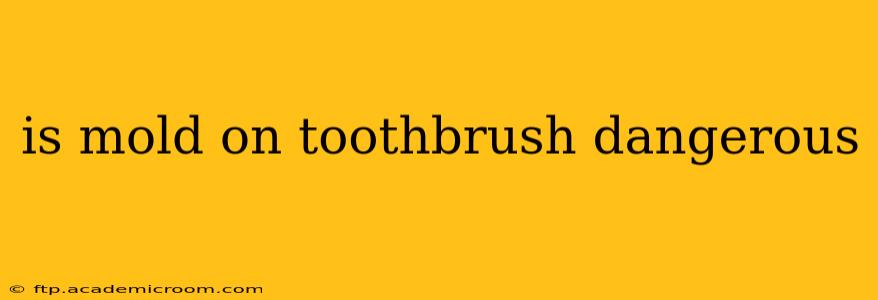Finding mold on your toothbrush is undeniably unsettling. The immediate question: is it dangerous? The short answer is yes, it can be. Mold, a type of fungus, can harbor various species, some of which produce mycotoxins – harmful substances that can cause a range of health problems. This article delves into the dangers, prevention, and what to do if you discover mold on your toothbrush.
What Kinds of Mold Can Grow on Toothbrushes?
Several types of mold can thrive in damp, humid environments like bathrooms, making toothbrushes particularly vulnerable. Common culprits include Aspergillus, Penicillium, and Cladosporium. The specific species will determine the severity of potential health risks. Identifying the exact type usually requires laboratory analysis, which isn't typically necessary for a household situation. The presence of any visible mold is a sufficient reason for concern.
What Happens if You Use a Moldy Toothbrush?
Using a moldy toothbrush can lead to several unpleasant and potentially harmful consequences:
-
Oral Infections: Mold spores can irritate the gums and oral mucosa, leading to infections like thrush (candidiasis) or other fungal infections of the mouth. People with weakened immune systems are at higher risk.
-
Respiratory Issues: Inhalation of mold spores, especially during brushing, can trigger allergic reactions such as sneezing, coughing, and wheezing. In individuals with asthma or other respiratory conditions, this can worsen existing symptoms.
-
Gastrointestinal Problems: While less common, swallowing mold spores can potentially lead to gastrointestinal distress, including nausea, vomiting, or diarrhea.
-
Systemic Infections: In rare cases, particularly for individuals with compromised immune systems, mold exposure can lead to more serious systemic infections. This is less likely with a toothbrush, but still a possibility.
How Can I Tell if My Toothbrush Has Mold?
Mold on a toothbrush isn't always easily visible. Look for:
-
Visible Fuzzy Growth: The most obvious sign is the presence of fuzzy, discolored patches (often black, green, or white).
-
Musty Odor: A musty or earthy smell emanating from the toothbrush is another strong indicator.
-
Discoloration: Even without visible fuzzy growth, a change in the color of the bristles (especially if it's not due to staining from toothpaste) could be a sign.
How Often Should I Replace My Toothbrush?
The American Dental Association (ADA) recommends replacing your toothbrush every three to four months, or sooner if the bristles are frayed. This routine replacement minimizes the risk of mold growth and bacterial accumulation. Replacing your toothbrush after an illness is also a good preventative measure.
Can I Clean a Moldy Toothbrush and Reuse It?
No. Cleaning a moldy toothbrush is not recommended. Even thorough cleaning may not eliminate all mold spores and mycotoxins. Discarding the toothbrush is the safest course of action.
What Should I Do If I Find Mold on My Toothbrush?
If you discover mold on your toothbrush, immediately discard it. Thoroughly clean the toothbrush holder with a bleach solution (1 part bleach to 10 parts water) to prevent further mold growth. Replace your toothbrush with a new one.
Is Mold on a Toothbrush More Dangerous for Children?
Yes, children are generally more vulnerable to mold exposure due to their developing immune systems and the likelihood of ingesting mold spores. Extra vigilance is crucial when it comes to children's oral hygiene.
What are the best ways to prevent mold on a toothbrush?
-
Proper Storage: Store your toothbrush upright in a well-ventilated area to allow it to air dry completely after use. Avoid closed containers.
-
Regular Cleaning: Rinse your toothbrush thoroughly after each use to remove any residual toothpaste, food particles, and saliva.
-
Replacing Toothbrushes Regularly: Follow the ADA's recommendation to replace your toothbrush every three to four months.
-
Clean Toothbrush Holders: Regularly clean your toothbrush holder with soap and water or a bleach solution to eliminate mold spores.
Finding mold on your toothbrush is a clear sign that it's time for a replacement. Prioritizing oral hygiene and taking preventative measures will significantly reduce the risk of mold growth and protect your oral and overall health. Remember, prevention is key!
